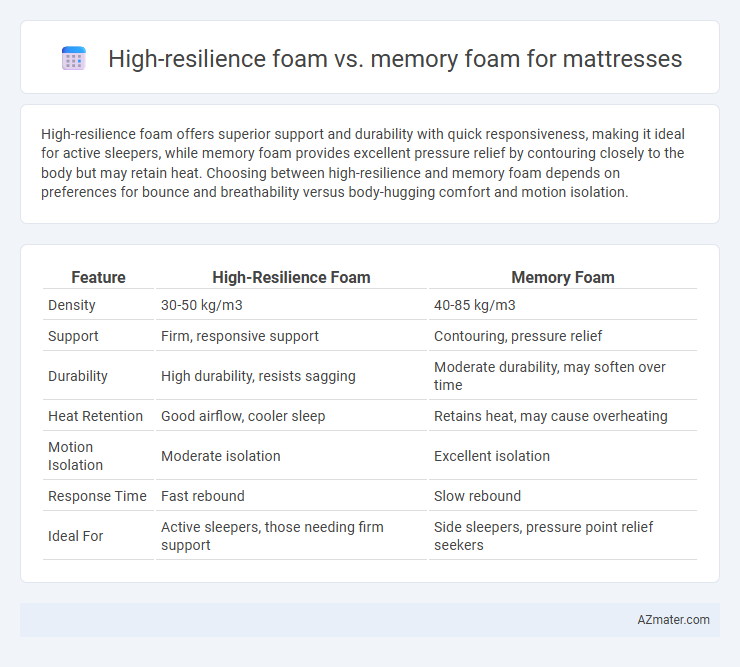High-resilience foam offers superior support and durability with quick responsiveness, making it ideal for active sleepers, while memory foam provides excellent pressure relief by contouring closely to the body but may retain heat. Choosing between high-resilience and memory foam depends on preferences for bounce and breathability versus body-hugging comfort and motion isolation.
Table of Comparison
| Feature | High-Resilience Foam | Memory Foam |
|---|---|---|
| Density | 30-50 kg/m3 | 40-85 kg/m3 |
| Support | Firm, responsive support | Contouring, pressure relief |
| Durability | High durability, resists sagging | Moderate durability, may soften over time |
| Heat Retention | Good airflow, cooler sleep | Retains heat, may cause overheating |
| Motion Isolation | Moderate isolation | Excellent isolation |
| Response Time | Fast rebound | Slow rebound |
| Ideal For | Active sleepers, those needing firm support | Side sleepers, pressure point relief seekers |
Introduction to Mattress Foam Types
High-resilience foam offers superior support and durability with an open-cell structure that enhances airflow and resilience, making it ideal for responsive comfort. Memory foam conforms closely to body contours, providing pressure relief and motion isolation through its viscoelastic properties but tends to retain heat. Understanding these fundamental characteristics helps in selecting a mattress that balances support, comfort, and temperature regulation based on individual sleep preferences.
What is High-Resilience (HR) Foam?
High-resilience (HR) foam is a durable polyurethane foam known for its excellent support and quick response to pressure, making it ideal for mattresses that require both comfort and longevity. Unlike memory foam, which contours slowly to the body and retains heat, HR foam maintains a cooler sleep surface and provides better airflow due to its open-cell structure. Its high density and resilience contribute to superior spinal alignment and pressure relief, offering balanced comfort without the sinking sensation characteristic of memory foam.
Understanding Memory Foam
Memory foam mattress material conforms closely to body contours, providing targeted pressure relief and reducing motion transfer for improved sleep quality. High-resilience foam offers faster responsiveness and greater durability, making it more suitable for those seeking a balance of support and comfort. Understanding memory foam's viscoelastic properties highlights its ability to absorb impact while maintaining temperature sensitivity, enhancing personalized comfort during sleep.
Comfort and Support Comparison
High-resilience foam offers superior support by maintaining its shape and providing consistent firmness, ideal for those seeking a responsive mattress that reduces pressure points. Memory foam contours closely to the body, delivering tailored comfort by evenly distributing weight and enhancing spinal alignment. While memory foam excels in motion isolation and body contouring, high-resilience foam outperforms in durability and quick recovery, making it a preferred choice for long-term support.
Durability: High-Resilience Foam vs Memory Foam
High-resilience foam offers superior durability with a tough, flexible structure that retains its shape and support over time, making it ideal for long-lasting mattress performance. Memory foam tends to soften and lose its responsiveness faster due to its viscoelastic properties, which can lead to sagging and reduced support after prolonged use. Choosing high-resilience foam ensures enhanced mattress longevity, especially in high-traffic or heavy-use situations.
Temperature Regulation and Breathability
High-resilience foam offers superior temperature regulation and breathability due to its open-cell structure that promotes airflow and dissipates heat effectively. Memory foam tends to retain body heat because of its dense composition, which can lead to less efficient temperature control and reduced breathability. Choosing high-resilience foam can enhance cooling comfort and airflow, making it ideal for hot sleepers or warm climates.
Motion Isolation Capabilities
High-resilience foam features an open-cell structure that offers moderate motion isolation by quickly absorbing movement, making it suitable for active sleepers. Memory foam excels in motion isolation due to its viscoelastic properties that contour closely to the body, minimizing motion transfer between sleep partners. For couples seeking superior motion isolation, memory foam mattresses typically outperform high-resilience foam by significantly reducing motion disturbances during sleep.
Allergy and Health Considerations
High-resilience foam mattresses offer superior airflow and moisture resistance, reducing the buildup of allergens such as dust mites and mold, which benefits allergy sufferers. Memory foam tends to retain more heat and moisture, potentially promoting allergen growth and requiring regular maintenance to prevent adverse health effects. Choosing hypoallergenic, antimicrobial treatments in either foam type enhances protection against common irritants and supports respiratory health.
Price and Value Differences
High-resilience foam mattresses typically offer greater durability and support at a lower price point compared to memory foam, making them a cost-effective choice for long-term use. Memory foam mattresses generally come with a higher upfront cost but provide superior contouring and pressure relief, enhancing sleep quality for those with specific comfort needs. Evaluating the value of each foam type depends on balancing initial price against longevity, comfort preferences, and individual health requirements.
Choosing the Best Mattress Foam for Your Needs
High-resilience foam offers superior durability and bounce, making it ideal for those seeking long-lasting support and responsiveness, while memory foam excels in contouring to the body's shape, providing pressure relief and motion isolation. Selecting the best mattress foam depends on individual sleep preferences, with high-resilience foam favored by back and stomach sleepers for its supportive qualities, and memory foam preferred by side sleepers who need enhanced cushioning. Consider factors like body weight, sleeping position, and desired firmness to determine which foam will optimize comfort and spinal alignment.

Infographic: High-resilience foam vs Memory foam for Mattress
 azmater.com
azmater.com